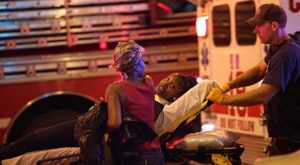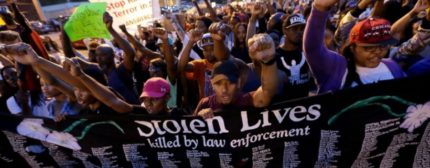
Byron Champ, 21, and Kewane Gatewood, 20, were charged with three counts of attempted murder and aggravated battery with a firearm.
“These charges are just the beginning, and this investigation remains ongoing at this time,” police Superintendent Garry McCarthy said in the statement.
Champ was previously convicted of unlawful use of a weapon by a felon in July 2012 and sentenced to boot camp at a Cook County facility, said police, who called him a gang member.
Champ being “back on the streets to be part of this senseless shooting” was “unacceptable,” McCarthy said.
Of the 13 people shot, there were 10 adults, two teenagers and a 3-year-old, who was the most seriously hurt by gunshot that hit him in the ear and exited through his mouth.
Chicago police did not release many details of the shootings except to say it appeared to be gang-related, according to The Associated Press. It took place on a basketball court on the 51st Street side of Cornell Square Park.
A man who was at the scene said he didn’t hear any sounds coming from the 3-year-old when three police officers carried the child to an ambulance.
The boy was identified by family members as Deonta Howard, whose uncle was shot to death on Labor Day, Sept. 2. He is called “Tay Man” by his family.
“He didn’t like haircuts because he has a big head,” Porsche Chester, a cousin, told the AP. “But he is extremely smart. He didn’t have that (head) for nothing.”
The child’s uncle, Julian Harris, told the Chicago Sun-Times that he saw dreadlocked men in a gray sedan shoot at him, before turning toward nearby Cornell Square Park and opening fire. He said his nephew was shot in the cheek.
“They hit the light pole next to me, but I ducked down and ran into the house,” Harris said. “They’ve been coming round here looking for people to shoot every night, just gang-banging stuff. It’s what they do.”
The Chicago Tribune reported on Monday that Deonta was “making a quick recovery” and is expected to be released from the hospital within a few days.
Though Chicago officials contend that the wave of violence is abating, there were six people killed and 28 others wounded in shootings during one weekend at the end of August. After that incident, one of the injured victims, a 7-year-old boy who was shot on his front step while bringing a bicycle inside, was afraid to go outside a week before the start of school.
At the start of school last month, Chicago officials delivered safe passage along routes to 90 city schools for students on opening day of the nation’s third largest school system. The schools were being closely watched after 50 were closed earlier this year, prompting fears that some students could be in danger by attending new schools in neighborhoods where they might encounter rival gangs.
While city officials point to statistics indicating a reduction in violence — 266 people were killed as of the end of August this year, a decrease of 26 percent from last year—the high-profile, shocking murders and shootings continue.
Last month an 11-year-old girl was shot while sitting with her family on the porch of her Northwest-Side apartment building and a 14-year-old boy killed while standing with a group on the city’s West Side.
Illinois Governor Pat Quinn offered to send the National Guard into the city to help police, but McCarthy is against the proposal.
“The National Guard is not a policing force, they are a military force,” he said on Monday at a graduation ceremony for new police officers.
According to numbers released last week by the FBI, Chicago is now the murder capital of the U.S., with more homicides than any other city in 2012. Gun violence in Chicago led to more than 500 murders in 2012, according to the FBI report, while New York City, with three times Chicago’s population, had 419 murders in 2012.
But as noted by the Washington Post, residents in other places were still more likely to be victims of homicide than residents in Chicago and New York.
For example, in Flint, Michigan, there were 63 killings last year. Since Flint has a population of 101,632, that means 1 in every 1,613 city residents were homicide victims. In Detroit, where there were 386 killings in 2012, 1 in 1,832 were homicide victims.

